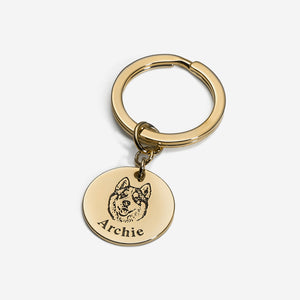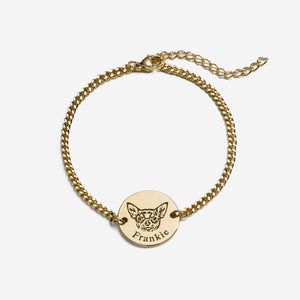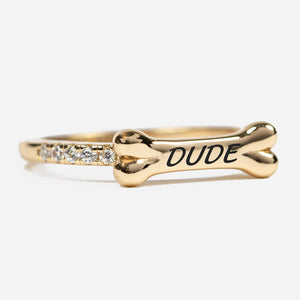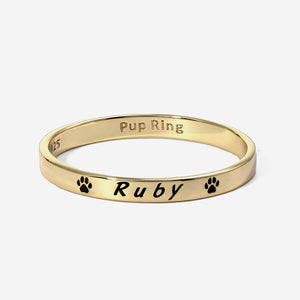When you think about getting your dog the exercise it needs, you probably just think about going on walks or spending some time playing tug. While you’re not wrong, that’s only half the story!
In order to be the healthiest (and best-behaved) pup, your dog needs to work its brain too! Mental exercise for dogs helps them stay well-rounded and emotionally sound. It is even more important for senior dogs, because it helps keep them sharp and mentally present much longer into their life. It’s good for dogs that aren’t able to do as much physical exercise too. So without further ado, here are 10 ways to work your dog’s brain!
1. Let Them Sniff!
A sniff walk is an easy way to let your dog explore one of its strongest senses. Maybe your dog already has a tendency to let its nose lead it! This isn’t just a coincidence. In fact, a dog gets so much information through its nose, their sniffer almost more useful to it than their eyes! Their brains are wired to take every little scented molecule and weave together a whole story. All of this means that, by giving your dog the chance to take in brand new smells is naturally an easy way to really work their minds!
All you have to do is take your dog out for a walk, and instead of speeding along your normal route, you can either slow down along your usual path, or take your dog to a brand-new place to really pick up on even more unfamiliar smells. Just make sure that you set aside a generous, dedicated amount of time for your dog to smell the roses- and everything else too.
2. Practice Some “Nose Work” Games
You can also be more deliberate about creating opportunities for your dog to use its nose (and in turn, its brain!). There are tons of games that you can create for your dog, which is especially useful when you’re stuck indoors due to things like bad weather.
You could do something as simple as hiding treats around the house for your dog to find. You can encourage your dog to think outside the box and explore by putting a super smelly snack somewhere accessible but out of sight. Put it under a box, or near a place that you’d like your dog to visit more often. This is especially helpful for the beginning stages of kennel training! Leaving some really good treats in your dog’s kennel for them to find on a random basis encourages them to visit it more often and form a positive association with the crate.
You can also try doing something similar to the “shell game”- let your dog watch you put a treat underneath a cup, and mix it up with other cups. Your dog will probably be able to smell the treat to find it, but they also learn to pay attention and think a little more about the movement of the cups.
3. Try Other Interactive Games
Taking the time out of your day to play interactive games with your dog is great for its social health, and it’s also another way to turn on that brain!
 Hide and seek is a great, easy game to play with your dog. Your dog can use its nose a little bit for this game, but it can also use its sense of hearing and general curiosity. Hide and seek is great for reinforcing your dog’s recall command too. It’s easy to tailor the difficulty for your pup, between how well you hide or how many hints you give them.
Hide and seek is a great, easy game to play with your dog. Your dog can use its nose a little bit for this game, but it can also use its sense of hearing and general curiosity. Hide and seek is great for reinforcing your dog’s recall command too. It’s easy to tailor the difficulty for your pup, between how well you hide or how many hints you give them.You can also teach your dog the names of toys, other objects, and people! This comes in handy in a lot of situations, but you can also play hide-and-seek with your pup’s favorite stuffed animal. Think of it as a more interesting version of fetch!
4. Have Them Work For Their Food
Getting your dog to work for their food has a few interesting benefits! It incorporates a bit of extra thinking into a typically uneventful daily routine that already exists for both you and your pup. It’s also great for slowing down dogs who tend to eat too quickly, which can cause an upset stomach or even a potential choking hazard.
While there are special food bowls that you can buy for this, you can also do things like simply spread their food out on a large pan so it’s harder to take huge gulps at once. Maybe you can split their meals between more than one bowl in different places. Or, if you are going really heavy on the training, reserve part of your dog’s meal to use for rewards! This is especially good for your pup (and your wallet!) since treats tend to be higher in calories and more expensive. Feeding part of your dog’s meal in one of the larger puzzle toys (more on that later!) is also a great way to keep them occupied for a period of time (although that may vary depending how sharp your pup is already!)
5. Rotate The Toys They Already Have
One of the simplest ways you can keep things fresh for your pup is by rotating their toys! My dog Cookie is a bit of a hoarder sometimes, but when I put up all but 1 or 2 of his toys, and switch them out, he is always much more enthusiastic about hanging out with his duckie, or his rope, or even his squeaky pig. Rotating your dogs toys will keep them consistently excited with the things that they own, and that also means you don’t have to go out and buy something else every time they get bored. It’s a win-win situation!
6. Try Some DIY Puzzle Toys
While you’re saving money by rotating your dog’s existing toys, you can also give them some puzzles to do without spending $30 on a rubber ball with a hole in it that they sniff once and never look at again, or something advertised as “indestructible” that winds up falling to pieces within 10 minutes of its initial encounter with your overenthusiastic pup.
 One of the simplest puzzle toy concepts is to simply take your dog’s favorite ratty tennis ball and cut a hole in it large enough to insert treats or a portion of your dog’s normal food into! Just cutting a slit that opens up when the ball is squeezed is an easy way to encourage your dog to do some extra appropriate chewing while trying to figure out how to get the food out.
One of the simplest puzzle toy concepts is to simply take your dog’s favorite ratty tennis ball and cut a hole in it large enough to insert treats or a portion of your dog’s normal food into! Just cutting a slit that opens up when the ball is squeezed is an easy way to encourage your dog to do some extra appropriate chewing while trying to figure out how to get the food out.
You can make a diy rope toy with dried goodies on it too! Use hemp or jute rope, since it is a little tougher, and much less likely to make your pup sick if a bit is ingested. Cut a sweet potato into slices, cut holes in the middle a little larger than the rope, and dry them in an oven at 250 degrees Fahrenheit for 5 hours, flipping halfway through. Let them cool, and go to town threading them on the rope, tying knots between each slice. This toy is good for dogs who have destructive tendencies too, since it’s cheaper than buying new toys all the time and will slow them down as they munch on those dried goodies. And even if you're going to be a couch potato while your dog snacks away, make sure that, like any other toy with small parts or the potential to shred, you supervise your dog while they chew away at it.
By the way, if you like the concept of do-it-yourself entertainment for your pup, let us know! Maybe it would make a great topic for an article all on its own!
7. Learn To Play Shaping Games
You can teach your dog to do just about anything through shaping (which you can read all about here!). You don’t always have to have a detailed plan or even a goal though. If you’re in the mood to hang out with your dog for a while, give them something interesting to interact with and see what they do! If your dog hasn’t practiced shaping before it may take a while to get them interested or started, but when they start getting curious, it gets interesting!
 The best example of this is to present your dog with a box. Hang out, point at the box, turn it over, maybe you can step inside and get your dog curious about what you’re doing. Keep some rewards or treats handy, and when your dog tries something interesting, let them know! Even if your dog doesn’t immediately do something amazing, the beauty of shaping is recognizing that anything they do is just a step towards doing something else. You can even reward them for just trying new things. Give them a reason to think outside the box and watch your dog learn to enjoy exploration!
The best example of this is to present your dog with a box. Hang out, point at the box, turn it over, maybe you can step inside and get your dog curious about what you’re doing. Keep some rewards or treats handy, and when your dog tries something interesting, let them know! Even if your dog doesn’t immediately do something amazing, the beauty of shaping is recognizing that anything they do is just a step towards doing something else. You can even reward them for just trying new things. Give them a reason to think outside the box and watch your dog learn to enjoy exploration!
8. Give Them New Experiences
Giving your dog new experiences, especially early on in life, is incredibly important. Encountering new situations, places, people, or creatures helps your dog become well-rounded and confident. New experiences also give them a lot to think about!
“Hey, that person has something funny on their head. That’s new. Oh, that thing looks and acts a little different than I do, I wonder what it is! I haven’t been to this place before. What can I learn about this place and the things that happen here through sight and smell?”
 Okay, so your dog doesn’t think these exact words in their head, but this is more of a demonstration of what natural curiosity occurs when a dog experiences anything new. The same thing has probably happened to you too! When you were younger maybe you grew up in the country and didn’t see a train for a long time, or maybe you grew up in the city and never met a horse until you were an adult. Enabling this natural sense of curiosity to occur opens up the opportunity to think new thoughts, or be comfortable in even more situations that we (or our dogs!) haven’t experienced before. If you’re in the mood to feel that sense of wonder alongside your dog, look for some opportunities to try something new!
Okay, so your dog doesn’t think these exact words in their head, but this is more of a demonstration of what natural curiosity occurs when a dog experiences anything new. The same thing has probably happened to you too! When you were younger maybe you grew up in the country and didn’t see a train for a long time, or maybe you grew up in the city and never met a horse until you were an adult. Enabling this natural sense of curiosity to occur opens up the opportunity to think new thoughts, or be comfortable in even more situations that we (or our dogs!) haven’t experienced before. If you’re in the mood to feel that sense of wonder alongside your dog, look for some opportunities to try something new!
9. Give Your Dog A Job
Dogs were bred and domesticated over thousands of years to perform special tasks for us. Some breeds are a little more work-focused than others, but that doesn’t mean your medium-sized-unambiguously-shaped-and-colored dog won’t love doing some work too! Even if you think doing a chore is a bore, your dog is naturally wired to be excited at even the idea of having a task to fulfill. Not only is the process of teaching your dog to do a job especially thought-inducing, but giving your dog a purpose will remind you of how much your dog wants to please you! You can read more about giving your dog a job here if you want some specific tips and tricks, or even general ideas of jobs your dog can do!
10. Training, Training, And More Training!
 If you’ve been here before, you have heard it a thousand times- it’s so good to spend time training your dog! Sure, your dog will know how to sit and stay, and that’s useful. It’s nice when your pup goes on a good walk and doesn’t drag you along. When your dog learns how to live in harmony with your household thanks to proper training, it feels pretty good!
If you’ve been here before, you have heard it a thousand times- it’s so good to spend time training your dog! Sure, your dog will know how to sit and stay, and that’s useful. It’s nice when your pup goes on a good walk and doesn’t drag you along. When your dog learns how to live in harmony with your household thanks to proper training, it feels pretty good!Training is more than getting an angel of a dog though. When you spend time training your dog, you’re giving them the opportunity to think a little more critically than usual. Teaching your dog to learn, and to love the process of learning, is a direct way to unlock and reinforce their natural curiosity in brand new ways.






